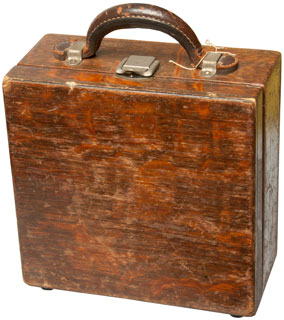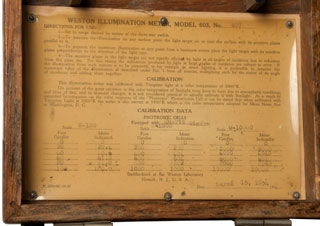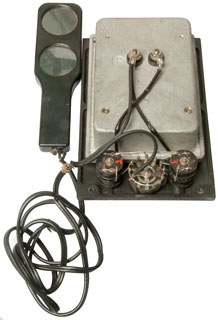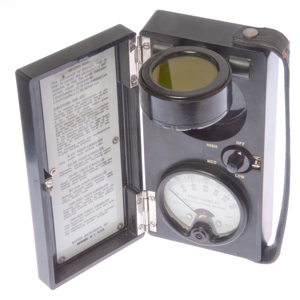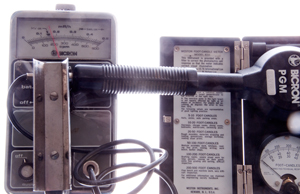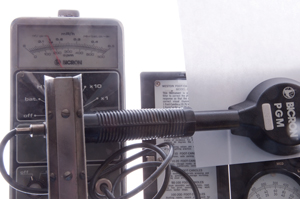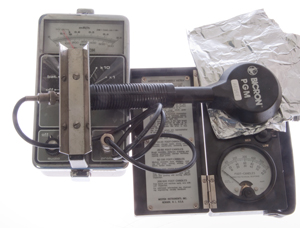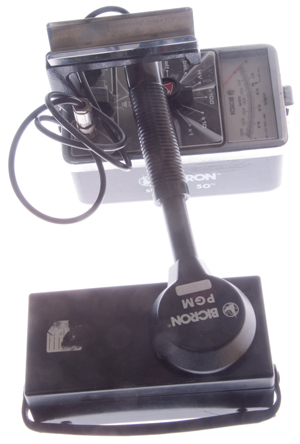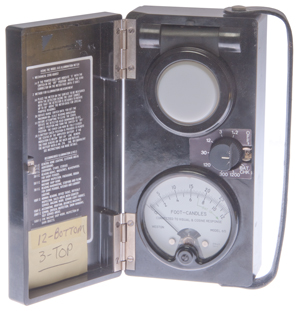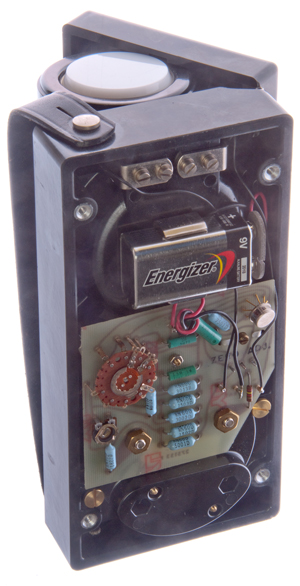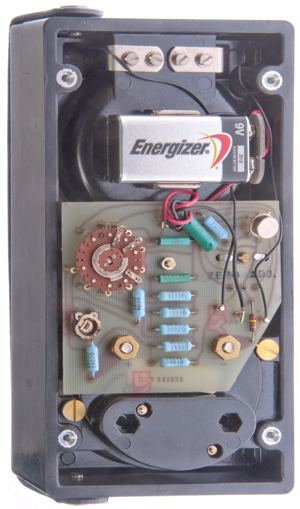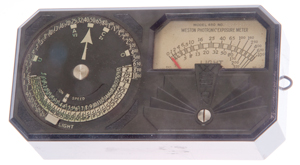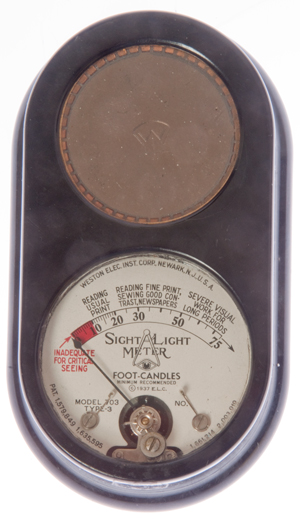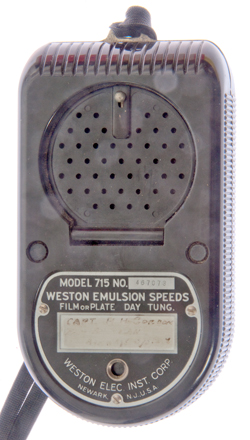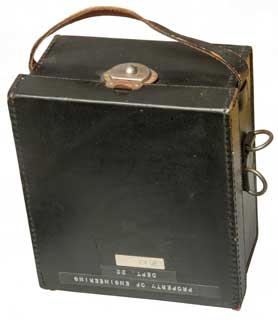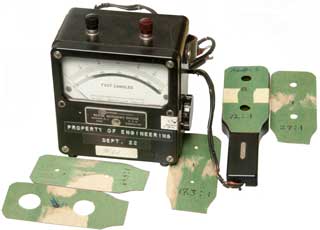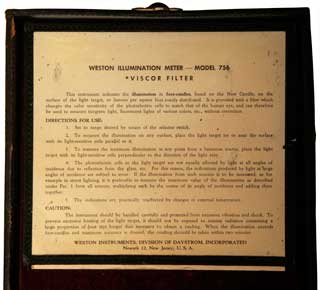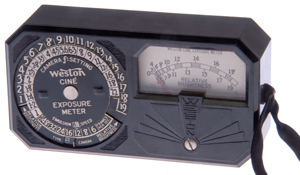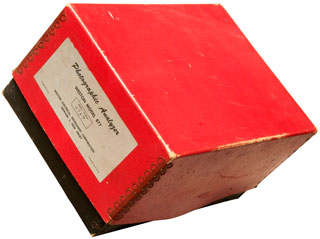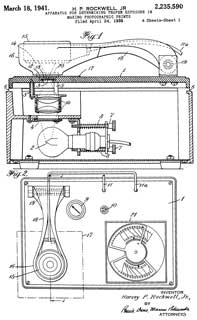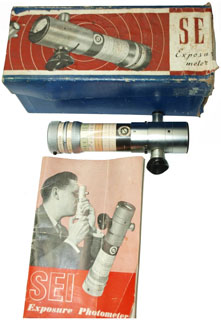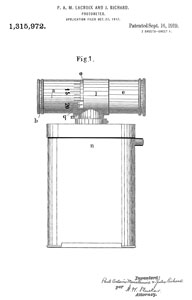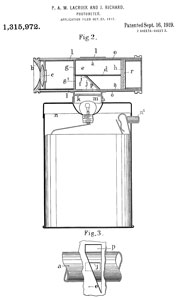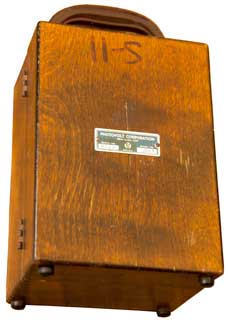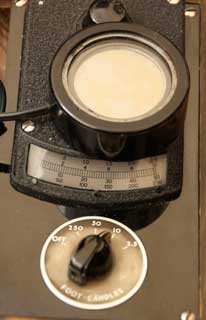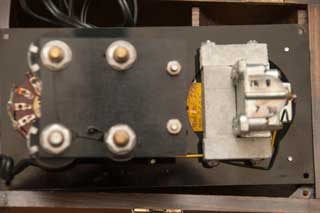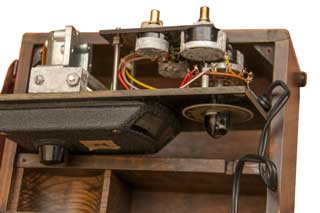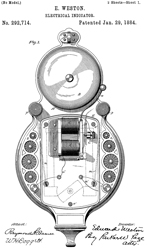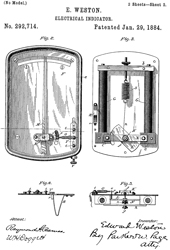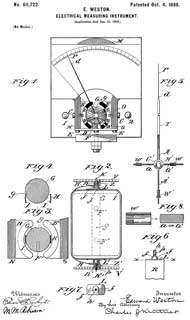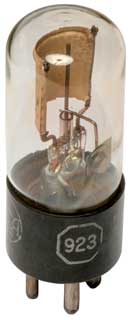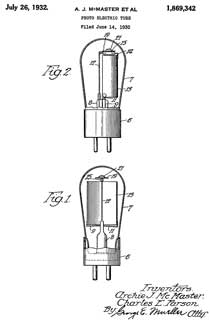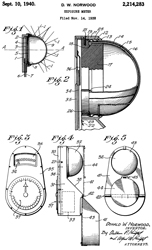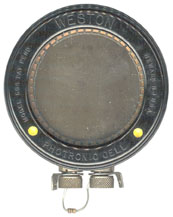 |
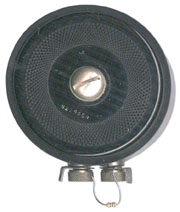 |
Box on eBay:
Matched Cell AT 25 FC & 200 Ohms Dwg. 69996 S--51188 S.O.79404 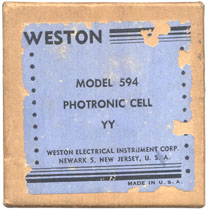 |
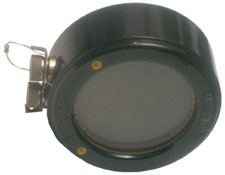 |
Description
Prior art Photoelectric Cells did not have a stable light to output conversion factor, they degraded over time so could no be used to make a light measuring instrument.
This is a Selenium based photo cell where each cell only generates a small voltage, but with strong current and so a number of these can be connected in series to get a useful current. This version (called YY or Yellow Yellow (see the color dots in photo above) has an output of 46 to 58 micro amps at 20 foot candles with a 200 Ohm load. The (output at 200 fc) / (output at 20 fc) >= 8.6. The 200 Ohm load was used back in the vacuum tube days, but today a virtual short input operational amplifier will improve the linearity compared to what you would get with the 200 Ohm load.
There are different filters available for the 594 but I don't yet know which is on this one.
603 Illumination Meter
This may be the first combined instrument? That's to say a Photonic Cell and a meter so that light could be measured.
Fig 1
Fig 2 This is serial 607
Fig 3 This is serial 607 and comes with a custom calibration.
The serial 2410 Model 603 did not have a calibration.
see: https://www.westonmeters.info/weston-meter-model-603
The above web page dates the 603 model to 1937, but
the calibration certificate here is dated March 15, 1954.
Fig 4 The wire insulation has biodegraded which
is probably why the meter does not read light levels.
Fig 5 Inside
Fig 6 Meter Movement
While installing new probe wires I checked the photocells
and the output was near nothing, so probably a defective probe.
Also the meter movement is missing the return spring. so. . .
this appears to be a parts mule, i.e. a meter whose good parts
were used to restore another meter and is now a collection
of bad parts.
Weston 614 Foot-Candle Meter (Reflected Light Meter?)
The 614 and 615 light meters are very similar and I think they both use either the 594 cell or a version of it based on the wording in their description.
"Corrected to Visual Response" on meter face.
The photocell in both the 614 and 615 meters can be rotated up about 90 degrees so that you can hand hold the meter in your right hand using the strap while walking around a room and measure the light intensity falling on a horizontal surface (the photo cell surface should be parallel to the surface being measured.
The 614 does not need a battery. It only contains the photocell and some wire wound resistors for the range switch.
mentioned in patent: 2050224Projector for color motion pictures - filed Sep 5, 1933 - so in use then.
Still photographers typically use reflected light metering (Wiki: light meter), i.e. from the camera position looking at the subject.
When the pancake probe of a Bicron 50 radioactive Survey meter is placed on top of the photocell it reads 20,000 counts per minute.
But when the Bakelite (Wiki) lid is closed the reading drops to background count.
Weston 614 Foot Candle Meter
Weston 614 Foot-Candle Meter with photocell rotated up
Inside
Radioactivity measured using Bicron 50 Surveyor & PGM pancake probe.
The radioactivity is coming from the photocell and not other
parts of the 614.
When a sheet of copy paper is placed between the photocell
and the probe there is a slight drop in the count.
Without Paper CPM = 20,500
With Paper CPM= 17,500 (varies from 17,000 to 20,000)
When Aluminum foil folded twice (4 layers) is interposed
the Counts Per Minute drops slightly more than for paper.
Without Aluminum foil CPM = 20,500
With 4 layers of Aluminum foil CPM= 13,500
When the Bakelite lid (3.9mm thick) is closed no radiation is sensed.
One theory is that they use thorium for refraction reduction and uranium for color filtering?
With Bakelite cover closed CPM = 0
Weston 615 Illumination Meter (Incident Light Meter?)
The 615 meter uses a common 9 Volt battery and contains an op amp and associated precision metal film resistors.
The 615 has a white cap on the photocell.
"Corrected to Visual & Cosine Response" on meter face.Movie photographers typically use incident light metering, i.e. the light meter is at the subject location and measures the light falling on the subject. The Sekonic movie light meter (Wiki) has a white hemisphere on a swivel mount and it is the brand I used with a Bolex H16 16mm camera (Wiki).
Since the Model 614 and 615 have sequential model numbers and one is for still photography and the other is for movie photography, they may be the first light meters intended to measure light for the purpose of exposing film. But the table inside both models is for light for various tasks like reading, etc.
The Geiger counter reading is only 4,000 counts per minute for this meter, much less than for the 614 above. Probably because the white diffuser blocks the radiation.
With the Bakelite lid closed only background radiation is measured.
Weston 617
Uses two the 594 cells (maybe to get enough power to drive an analog meter movement).
Federal Reporter, 2nd Series, Vol 133. pp. 778-781; WESTON ELECTRICAL INSTRUMENT CORPORATION et al. v. DEJUR-AMSCO CORPORATION - info on use of honeycomb to control look angle.
Ollinger's - Light Meter Collection - 617 Type 1 -
Scott's Photographica Collection - Weston Electrical Instrument Corp. Model 617 Exposure Meter -
Weston 7
One of the earliest photoelectric exposure meters and marked the introduction of the Weston film speed system (Wiki).
It wasn't till 1949 that the Weston exposure meters switched to the then new ASA system.
Note: The difference between the Weston film speed and the official ASA film speed was a difference of 1/3 stop.
I expect at that time it amounted to no difference and may have been done so that Weston could not claim to be the total basis for the ASA system.
Weston 650 Photronic Exposure Meter
In the late 1920s film speeds (Wiki) were not yet standardized between manufacturers, so each brand had their own system.
Patents shown on front:
1579849 see below
1779574 see below
1982406 see below
Place for Emulsion Speeds
since films were not standardized.
Weston Film Ratings Booklet
D97827 Photoelectric Exposure Meter, Edward F. Weston (Weston Electrical Instrument Corporation), Dec 10, 1935, Application September 12, 1935, Serial No. 58,536
Weston 703 Type -3 Sight Light Foot-Candles Meter
About 1926 based on patents on meter face. Note not intended for photographic exposure, but rather Illumination (Wiki) and Photometry (Wiki), Foot-candle (Wiki).
1579849 see below
1635595 see below
1661214 see below
2003919 see below
Back Cover Removed
Weston 715 Master Light Meter
This is very similar to a light meter I used decades ago. I remember the hinged light baffle that also changed the meter scale.
Note in the photo where the baffle is opened the meter is reading the daylight in the room.

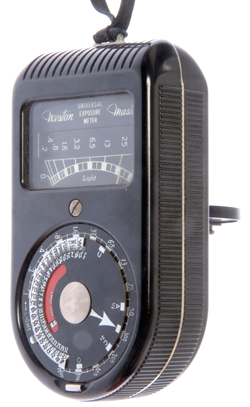

Weston 756 Foot Candle Meter
Weston 756 Illumination Meter with VISCOR filtered Photronic cells. Note the paddle probably has two sensors connected in series in order to get enough voltage to drive a passive (no batteries) current meter. The alternative at this time would have been a vacuum tube amplifier and many pounds of batteries to power it. The serial number of the paddle and meter are the same. The Engineering department that had this meter made a number of f/stop overlays, maybe to make it easier to use as a light meter for photography? The wire connected to the paddle has degraded and needs to be replaced. This is the model used when making the movie "Gone With The Wind" (Ref IMDB, WestonMeter.org).
Range switch: Off, 600, 120, 60, 12, 6
One the 6 Candlepower range one tick is 0.1 CP See Light Brightness Units below for some common values. Note daylight is over 15,000 CP, way off scale for this meter, hence the need for the f/stop masks.
Date stamp on back of meter: Dec. 10, 1964.
S/n on meter and target: 2770.
at the bottom of meter face:
Use only with target bearing same number as meter
New Candle Model 756 No. 2770 Viscor Filter
Fig 1
Fig 2
Fig 3 masks needed for use outside, since the Sun pegs the meter on the highest range.
Fig 4 Replaced degraded cord. Works fine.
Fig 5 Instructions in lid of box.
Harvard Collection: Weston Foot Candle Meter -
Weston 819 Cine Exposure Meter
Physically looks like the 650 still camera exposure meter, but the circular calculator and meter face are specific to movie cameras.
Dates: Instruction book 1937
Weston Film Speed booklet: 1938
Kodak K135 Kodachrome Film sheet: 2-1957
Patent numbers: identical to the Weston 650 above
A letter to the first owner explains how to use it for still cameras.
Weston Photographic Analyzer Model 877
This is a multi function instrument where one of those is measuring the density of a negative. This one way of determining the film speed. In the Ansel Adams Zone System (Wiki) where (AFAICR) first the enlarger exposure for unexposed film is determined to get solid black. Then an 18% gray card is exposed at various ASA values and after a standardized development process those are printed using the standardized enlarger process. Part of that is printing not only the exposed part of the film but also the space between frames that was not exposed and comparing those. For more on the Zone System see the SEI Photonic Spot Light Meter below.
Fig 1 Original box
Fig 2 Back
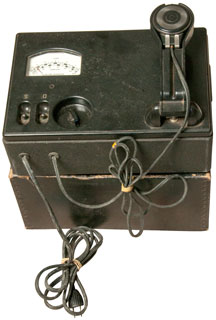
Fig 3 Front with model 594 Photonic cell unsnapped from head.

Fig 4
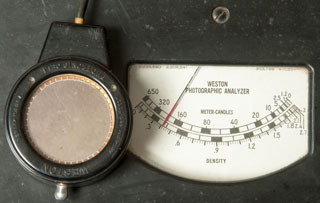
Fig 5
Fig 6
Patents:
877 manual at Camera Manuals.org.
1818003 Process and apparatus to be used in printing photographs from negatives, Joseph W Myers, (not assigned), Application: 1927-12-19, Pub: 1931-08-11,
2235590 Apparatus for determining proper exposure in making photographic prints, Jr Harvey P Rockwell, Weston Electrical Inst. Corp., 1941-03-18, - This is the model 877
2306641 Photographic exposure calculator, Jr Harvey P Rockwell, Weston Electric Instrument Corp, 1942-12-29 - Relates Negative density, illumination, Exposure time, paper speed. - built into the meter scale. (patent No. appears on meter scale.)
SEI Photonic Spot Meter
I used one of these to go along with the Ansel Adams (Wiki) Zone System (Wiki). This was the subject of a camera class at De Anza College. I used the Calumet 4x5 view camera for that class. The book for the class was The Zone System Manual by Minor White (Amazon).
See: Ollinger's Light Meter Collection - SEI Photometer -
Related Patents
165764 Improvement in photometers, O. Schuette, July 20, 1875 - variable density filter
464059 Photometer and actinometer (Wiki), L.H. Barker, Dec 1, 1891 -
552371 Method of and apparatus for measuring illumination, E.J. Houston & A.E. Kennelly, Dec 31, 1895 -
1315972 Photometer, P.A.M. Lacroix & J. Richard, Sept. 16, 1919 - French
This has the look and feel of the SEI, but it's much older and uses a
pocket flashlight battery.
Light Brightness Units
from Wiki Foot-Candle, Exposure Value,Lumens (Wiki) are a measure of the total visible light emitted by a source and it typically measured using an integrating sphere (Wiki). For example the Lumen output of a LED would be the same after it's lens was filed off as it was with a narrow beam. But the Foot-Candle reading with a narrow beam will be much higher than for the same LED after filing off the lens. Some LEDs have their light output specified in MCD (milli candelas Wiki) and they get high numbers by using a very narrow beam lens.
On the other hand some flashlights advertize high lumen numbers, meaning they contain a bright LED, but do not have the optics to focus all that light into a beam to provide a high Candela value on the subject being illuminated. The Xenide AEX25 1500 Lumen HID flashlight uses a High Intensity Discharge Xenon Short Arc lamp which allows designing an optical system that gets very close to all the light on the target, but an LED is far from a point source, i.e. it has a very directional light output pattern making it difficult to get all the light where you want it.
| Foot Candle |
Lux (lumen/m2) |
Exposure Value (EV) |
594 |
|
| Sunny Day | 15220 |
163,840 | 16 |
163
ma |
| open Shadow |
950 |
10240 | 12 |
0.55
ma |
| Indoor Art Gallery |
60 |
640 |
8 |
|
| Christmas Tree Lights |
4 |
40 |
4 |
|
| 1 |
10.764 | |||
| EV
reference (Wiki)
(1 sec f/1) |
0.23 |
2.5 |
0 |
|
| Indoors Window Light |
0.02
ma |
|||
| Maglite 2 AA Flashlight |
0.35
ma |
|||
| Full Moon, clear sky |
0.023 |
0.25 |
||
| Quarter Moon, clear sky |
0.0009 |
0.01 |
||
| Moonless, clear sky |
0.0002 |
0.002 |
Sunny Day 13 Mar 2009 39 deg North into ma range of Fluke 87 DMM.
A photographic light meter that reads in EV can be used to measure Lux. See Table 3 in the Wiki EV article
- L [lx] = 2.5 x 2EV
1860 - defined by the Metropolitan Gas Act 1860 (Wiki)
1909 - defined as 9/10 of the output of a Hefner Lamp (Wiki)
1921 - CIE defined in terms of a carbon filament Incandescent lamp (Wiki)
1937 - defined based on freezing point of liquid Platinum as 58.9 candles per square centimeter.
1948 - SI Candela (Wiki) replaced candlepower. 1 CP = 0.981 candela, but now they are considered the same. <- This is the meaning printed on the lower part of the meter face on the Weston 756 (dated: Dec 10, 1964)
Reference
John's Collection of Weston Meters - Publications & Further Reading -
The Photronic Photoelectric Cell, Monograph B-8, Weston Electrical Instrument Corp, Newark, NJ, 1935
1883 Fritts
1926 Lars O. Grondahl ( Union Switch & Signal Co)
1970135 Light Sensitive Apparatus, Aug 14, 1934, 136/255 ; 136/265; 250/214R - many prior patents for rectifiers
2089830 Light Sensitive Apparatus, Aug 10, 1937, 250/214SG ; 136/255; 136/265; 250/210; 250/214.1; 307/5; 361/173 - copper oxide w/ Large Bolt in Center
Chapter 3 Fundamental Concepts
Chapter 4 Some Practical Applications of the Photronic Cell
Chapter 5 Experiments
Chapter 6 Suggestions for Proper Instrument Use
Chapter 7 Bibliography
Patents
1579849 Pointer for electrical measuring instruments, Edward F Weston (Weston Electrical Instr Corp), Apr 6, 1926, 116/330 - helical spring screwed onto pointer for balanceIn the 1920s there was a lot of patent activity related to adding sound to moving pictures typically done using vacuum tube technology. There was also a lot of work on transmitting images electrically, later called television, again typically using vacuum tube technology. In both these applications speed of response was very important. But for measuring light for photography or to determine the light needed for various industrial applications a light meter with a response matching the human eye was required.
1635595 Electrical measuring instrument, E.F. Weston, et al (Weston Electrical Instrument Corporation), Jul 12, 1927, 324/151.00R, 324/156, 324/155 - meter movement
1661214
1779574
1982406
2003919 Meter, Canfield Earl L, Jun 4, 1935, 356/227 - Weston 703 (This patent and the ones above are related to the 703 meter)
2000642 Photoelectric Device, Anthony H. Lamb (Weston Electrical Instrument Co), May 7, 1935, 136/251 ; 136/244; 250/214.1; 257/42
Called by:
2699521 FILAMENT BAR CASING
2677715 OPTICAL-ELECTRICAL CONVERSION DEVICE COMPRISING A LIGHT-PERMEABLE METAL
2728809 METHOD OF MANUFACTURING PHOTO- ELECTRIC CELLS
2919353 SOLAR POWERED PORTABLE RADIO RECEIVER OR THE LIKE
3018377 PHOTOELECTRIC DEVICE
3036219 PASSIVE RADIATION PROXIMITY DETECTOR
3445686 SOLID STATE TRANSFORMER
2041816
Citations:
1940245
variable resistance - mixtures of platinum, osmium and iridium, either with or without palladium
1942958
1948766 Light sensitive cell (mounting methods)
2042665
2203209
2046665
2058562
2073790
2088070
313/538, 252/181.4, 427/74, 445/11, 445/12, 427/124, 204/164, 445/13, 427/126.5
2105255
2123670
Compact square with light sensitive rectangle in meter face.
2123470 Control Device, Anthony H. Lamb (Weston Electrical Instrument Co), Jul 12 1938, 361/173 ; 250/206; 250/214AL; 250/229; 250/554; 315/159; 361/157 -
2320185 Photoelectric Cell, Anthony H. Lamb (Weston Electrical Instrument Co), May 25 1943, 136/256 ; 257/E31.13 -
ridged surface so sensitivity is dependent on the direction of the incoming light.
Why? Ans: so that the included angle of light would match a normal 46 deg. camera lens.
See: Ollinger's Light Meter page & patent 1982406
2403863 Photoelectric Cell, Anthony H. Lamb (Weston Electrical Instrument Co), Jul 9, 1946, 136/256 -
Looks like Weston 703 Light meter.
May be for Photronic cells
2606215
136/259, 174/50.52, 228/124.6, 174/50.6, 174/50.54, 313/523, 174/564, 174/528
2629039 Selenium Cell and Process for Making Same, George H. Shoemaker (Weston Electrical Instrument Co), Feb 17 1953,
338/15 ; 136/264; 257/42; 257/E21.07; 29/620; 427/123; 427/372.2; 427/383.7; 438/102; 438/486 -
Simpler and better process to convert amorphous Selenium to crystalline form. In glass tube.
Calls:
866462 Selenium Cell, W.J. Hammer, Sep 17 1907, 338/19 ; 114/21.2; 136/259; 250/214.1; 338/237 - cell acts as variable resistance
2186085 Method of Making Selenium Rectifier Films, Samuel Weta (B-L Electric Mfg Co), Jan 9, 1940,
2342278 Manufacturing Selenium Cells, H. Herrmann (Germany), Feb 22 1944,
2364642 [typo in patent?]
2413013 Method of Making Selenium Rectifiers, A. Von (Federal Telephone & Radio Corp), Dec 24, 1946,
2479301Selenium Rectifier, Wayne E. Blackburn (Westinghouse), Aug 16, 1949, 257/42 ; 252/62.3S; 257/E21.071; 257/E21.073; 257/E21.074 - blocking layer
2855567
Patents that reference the Weston "Photronic Cell"
1940772 Oil TESTER
1990361
1993788 FIRE PREVENTION SYSTEM
1967583 TRANSPARENCY METER
1974522 COUNTING OP MICROSCOPIC BODIES-
2159181 ELECTRIC CONTROL SYSTEM
1938544 COLORIMETER
1940373 METHOD OF OIL TESTING
RE19255 METHOD OF TESTING Oil
2089859 SLOW ELECTROMAGNETIC RADIATION DEVICE
2068712 HIGH TEMPERATURE SLOW ELECTROMAGNETIC DEVICE
2051320 APPARATU for USING PHOTOELECTRIC - fatigue if exposed for an hour or so and wavelength dependent
2050486 AREA MEASURING MACHINE
2152645 PHOTOELECTRIC COLOR MEASURING AND ANALYZING APPARATUS
2054382 RADIATION PYROMETER DEVICE B
2111585 HEAD LAMP TESTING APPARATUS
2125639 APPARATUS FOR DETERMINING THE OPACITY OP PAPER AND OTHER MATERIALS
2149076 METHOD FOR THE MANUFACTURE OF CRYSTALLINE BODIES
2335655 CONTROL SYSTEM PANI S
2118082 COMPASS ALARM
2161004 PHOTOGRAPHIC DEVICE
2181841 MOTOR AND MOTOR-OPERATED APPARATUS
2114479 SHANNON AUTOMATIC STEERING COMPASS F
2184159 APPARATUS FOR MEASURING AREA O
2074641 MEASUREMENT OF HIGH TEMPERATURES
2171881 APPARATUS FOR MEASURING VISUAL EFFICIENCY
2102587 SOLAR NAVIGATOR
2177133 MEASURING INSTRUMENT
2239452 METHOD AND APPARATUS FOR PRODUCING SEMITRANSFARENT COATINGS
2230262 LIGHT POLARIZING SYSTEM
2232169 COLOBIMETEK IWUMS BL
2208147 PHOTOELECTEIC INCLINOMETER
RE22345 PROCESS FOR
2322225 CRANE ETAL
2298667 COLOR TEMPERATURE METER
2288807 AUTOMOBILE HEAD LAMP TESTING APPARATUS
2452038 PHOTOELECTRIC RADIO COMPASS TRAINER CONTROL
2454503 AUTOMATIC AURAL-VISUAL SIGNAL TRANSMITTER FOR AVIATION GROUND TRAINERS
2283190 FLIGHT INDICATOR
2323311 AUTOMATIC ALTITUDE CONTROL
2313733 LEVELING DEVICE
2333762 ANALYSIS
2397195 HEAT ABSORBING GLASS
2305442 BESSEMER CONVERTER BATH MEASURING
2892402 GRAVITY CONTROLLED MINE FIRING MECHANISM
2431899 PHOTROOSNTC CELL CIRCUIT
2501790 SILVERMAN
2489221 CRAFT LOCATING APPARATUS
2622221 FLUORESCENT DISCHARGE LAMP
2484809 COPY TABLE ASSEMBLY
2444442 PHOTO-ELECTRIC APPARATUS
2492148 AUTOMATIC NAVIGATING INSTRUMENT FOB CRAFT GUIDANCE
2467810 BARIUM MAGNESIUM LEAD SILICATE PHOSPHOR
2747455 DIFFERENTIAL REFRACTOMEIER
2780600 LEAD- AND MANGANESE-ACTIVATED CADMIUM-SODIUM FLUOROPHOSPHATE PHOSPHOR R
2899859 EXPOSURE METER FOR CATHODE-RAY TUBE PRESENTATION PHOTOGRAPHY
4380396 Method and apparatus for measuring the opacity of sheet material
GE Exposure meter Patents (from
model 8DW58Y) i.e. a model 58
Design probably from the late 1920s, using "GE" film
speeds. They switched to ASA film ratings in 1946 (Wiki).
Note: this meter says on back "For film or plates use
exposure index American Standard speed number". Sold
by the Army Exchange Service.
 |
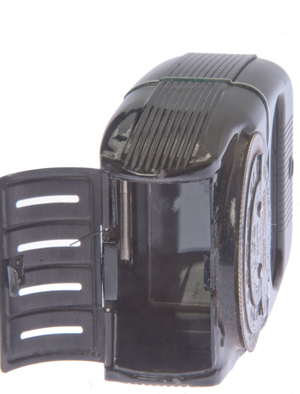 |
 |
The front just pulls off - snaps back
on |
1779574
2073790
2096170
136/256, 428/668, 428/621, 428/686, 428/931, 257/431, 257/E21.75, 257/42, 428/657, 204/192.26, 338/15
cadmium (sulfide?) gold
sensor
2196830
2209815
2296670
Photovolt 200A Foot Candle Meter
The Photovolt Corp was founded in 1939 according to their current web page.
Foot candle meter using a sensor very similar to the Weston 594 Photonic. Introduced in 1948 (Ollinger's Light Meter Collection).
Wiki has information on Exposure Value and how it relates to the light and camera settings. EV=5 : 7.43 fc (ISO 100).
The Model 200A has ranges: Off, 250, 50, 10 & 2.5.
The Model 200 has ranges: Off, 500, 100, 25 & 5.
The 200M model seems to have a nose on the sensor, maybe to fit a microscope? The range switch is OFF, Lo or Hi. Meter shows 0 to 100.
Fig 1
Fig 2 Black button above meter is zero adjustment knob.
The two pieces of wood inside the lid are for the exposure calculator.
Fig 3 just under 10 fc.
@ 200 ASA Nikon D300S says: f/5.3 & 1/3 secFig 4
Fig 5 Four adjustment post, one for each range.
Don't know what grunge is on metal parts? let me know.
3293540 Temperature compensated circuit arrangements, Bela A Silard, Schulkind Herbert, Photovolt Corp, 1966-12-20
Weston Meter Movement
D19896 Magnet, E. Weston, June 10, 1890 - Horseshoe type but with wide area where meter scale can fit.
D20318 Magnet, E. Weston,Nov 18, 1890 - has cylindrical field between the poles with narrow gap - for instruments.
292714 Electrical Indicator, E. Weston, U.S. Electric Light Co, 1884-01-29, -Fig 1 bell, Fig 2 meter.
D28392 Design for an index needle or hand, Edward Weston, March 22, 1898 - tubular for meter movement - balanced about pivot axis
392387 Electrical measuring apparatus, E. Weston, Nov 6, 1888 - uses the above designs
427022 Electrical measuring Instrument, E. Weston, Apr 29, 1890 - Fig 9 shows jewel for pivot.
446489 Electrical measuring Instrument, E. Weston, Feb 17, 1891 -
611722 Electrical measuring instrument, E. Weston, Oct 4, 1898 -
678706 Electrical measuring instrument, Edward Weston, 1901-07-16 -
678707 Art of manufacturing movable coils for use in connection with electrical measuring instruments, Edward Weston, 1901-07-16 - works with index needle above
678708 Apparatus for constructing movable coils of electrical measuring instruments, Edward Weston, 1901-07-16 - works with index needle above
730061 Reflecting-galvanometer, Edward Weston, 1903-06-02 -
Coils as Resistors
In many early test instruments where a resistor is needed it is made by winding copper wire into a helix or coil. Since the resistance of cooper wire varies with its diameter (AWG) and the Ohms per foot is directly related it's possible to predict the length of the wire needed as well as the cross sectional area required. The power rating also follows. But there are problems such as:
RE10944E Electric Conductor, E. Weston, July 17, 1888 - Copper alloy to nullify resistance change with temperature.
- The resistance changes with terperature
- The coil has inductance which may or may not be a problem
RE10945E Electric Conductor, E. Weston, July 17, 1888 - Copper alloy to nullify resistance change with temperature.
497482 Shunt for electric light and power stations, E. Weston, May 16, 1893 - stacked parallel plates
906498 Shunt or electrical resistance, Edward Weston, 1908-12-08 - for measuring high currents
Integrating Sphere (separate web page)
Used to measure total light output, like from an Edison lamp. Lumens are a measure to total light output and ignore any optics used to shape the light.
The Hipco flashlight uses s couple of lenses to get a very sharp beam.
Colorimeter
1495763 Colorimeter, Colorimeter Thomas D Simpson, Woodman A Clayton, Sinclair Refining Co, 1924-05-27, 356/70; 356/415; 434/98; 434/367; 434/388 - measure the color of lubricating oil according to an A.S.T.M. standard.
The Datacolor Syyder 4 measures the color of my LCD computer monitor.
The Photelometer determines the amount of oxygen in blood by it's color.
RCA 923 VT-252 Photocell (Wiki:
Phototube,
Photoelectric
Effect, Photocathode,
Einstein
Nobel Prize)
In the early 1900s there were a number of applications for sensing light. Mechanical television (Wiki) and talking pictures (Wiki) were big things.
(also see: Weston 594 Photronic Cell, Metascope\patents)
RCA 923 Phototube Frank.pocnet: 923Datasheet.pdf
Peak response 800 +/- 100 nm i.e. near IR
A photocell is used in the Western Union Desk Fax.
RCA 931 Photomultiplier
The Photomultiplier Handbook (Photomultiplier_Handbook.pdf) is the bible for these tubes and includes a lot of information about their development.
1. Introduction
2. Design
3. Electron Optics
4. Characteristics
5. Applications
Historical Applications:
Developed for an optical sound pickup used for motion pictures.Early applications: Astronomy and Spectroscopy, Radar Jammer (very wide band noise), Scintillation counting (PDR-56), headlight dimmers for cars, gamma camera (Wiki) for medicine,
The Secondary Emission Multiplier - A new electronic device, V.K. Zworykin, G.A. Morton, and L. Malter, RCA, March 1936, IRE Vol 24, No. 3. (Zworykin_Morton_Malter.pdf)
The only Nobel Prize Einstein won was for the Photoelectric Effect (Wiki). E=(mV2)/2. This is very similar to his equation E= mC2 (Wiki).
While the modern term for these is photomultiplier (Wiki) the patent (2231697) calls them Electron multipliers.
This was used in the PDR-56, maybe in the MD1 Star Tracker. Probably the first photomultiplier and AFAIK still being made. Used in all kinds of scientific instruments.
Frank.pocnet: 931A.pdf
Base: Small-shell Submagnal 11-pin.
S-4 Spectral Response, Cs3Sb, 950 Lumens/Watt, QE: 12%, See Photomultiplier Handbook page 16.
Fig 1
Fig 2 The light input grill is about 15/16" x 5/16".
Fig 3
Fig 4 Circular-cage multiplier structure
pg 28 Photomultiplier Handbook
Photocell & Photomultiplier Patents
1450265 Hot-cathode tube, Slepian Joseph, Westinghouse (CBS), App:1919-04-18, Pub: 1923-04-03, - secondary emission, Hot-Cathode,
1831314 Photoelectric tube, Archie J Mcmaster, Charles E Parson, GM Labs, 1931-11-10, - sensitive to visible light from a filament type lamp. copper photocathode plated with a mixture of caesium chloride and calcium. However, in most cases it is found desirable to admit an inert gas such as argon, helium, neon, krypton, Xenon, or even a less inert gas such as nitrogen, before the bulb is sealed off.
1858210 Electronic tube, Archie J Mcmaster, Charles E Parson, GM Labs, 1932-05-10, - Caesium salt on Copper photocathode
1869342 Photo-electric tube, Archie J Mcmaster, Charles E Parson, GM Labs, 1932-07-26, 313/523; 252/181.7; 427/77; 427/106; 427/108; 427/123; 428/929; 428/935; 428/937; 445/11; 445/12; 313/346R -
1903569 Electron tube, Kenneth W Jarvis, Russell M Blair, 1933-04-11, - early attempt at electron multiplier.
1909115 Optical system, Archie J Mcmaster, - single photocathode, for reading the sound track on motion pictures
1909701 Photoelectric tube, Archie J Mcmaster, single photocathode, not assigned, 1933-05-16, -
1925054 Photoelectric tube, Archie J Mcmaster, GM Labs, 1933-08-29, - single photocathode, , precursor to the GM Autronic Eye or GuideMatic?
1980702 Phototube, Salzberg Bernard, RCA, 1934-11-13, -First generation 2-starge, photomultiplier
1984312 Photocell circuits, Archie J Mcmaster, GM Labs,1934-12-11, - two tube transformer coupled amplifier for TV application.
Note this was the time of mechanical (flying spot) TV (Wiki).
2028153 Radiation detector, Gunn Ross (Wiki), 1936-01-21, - photocathode, selenium cell or thermopile as electron sources.
2035907 Photoelectric system, -photocell & relay driven counting
2073599 Electric discharge device, Malter Louis, RCA, 1937-03-09, - photo multiplier
2077634 Photoelectric tube, Archie J Mcmaster, GM Labs, 1937-04-20, - photocell
If we wish to obtain a tube which is highly sensitive to light in the red and yellow regions of the spectrum we use a caesium salt such as caesium chloride, caesium carbonate, caesium nitrate, caesium trinitride, caesium silicate, or caesium azide.
If we wish to obtain a tube responsive to shorter wave lengths we use potassium chloride, potassium carbonate, potassium nitrate, potassium trinitride, potassium silicate, or potassium azide.
For still shorter Wave lengths salts of the alkaline earth metals are used such as barium, strontium, and magnesium carbonates. All of these metals are high in the electromotive series. The method of processing the silver plated copper plate in the tube will first be described in connection with the caesium salts.
2077810 Phototube, Salzberg Bernard, RCA, 1937-04-20, - secondary emission amplification,
2078304 Electric discharge device, Vladimir K Zwerykin, Jr Ernest A Massa, RCA, 1937-04-27, - similar to 2073599, but longer
2082210 beam breaker - protection of hands of punch press operator
2147825 Electron multiplier device, Vladimir K Zworykin, Malter Louis, RCA, 1939-02-21, - uses magnetic filed to control electrons - multistage, not practical
2231697 Electron multiplier, Vladimir K Zworykin, Jr Richard L Snyder, RCA, 1941-02-11, -
probably the 931 Photomultiplier
2231698 Electron multiplier, Vladimir K Zworykin, Jan A Rajchman, RCA, 1941-02-11, - Photomultiplier
2241670 Electric target range, Archie J Mcmaster, Rayolite Rifle Range Co, 1941-05-13, - a flash of light from pistol is detected by phototube. A precursor to modern electronic games.
2308469 Exposure meter, Archie J Mcmaster, GM Labs, 1943-01-12, - does not use phototube
Cites:
1779574 Direct-reading photometer, Wein Samuel, Radiovision, 1930-10-28, -
1982406 Exposure meter, Tonnies Hans Ferdinand, 1934-11-27, -
2064987 Photometer, Reinhold Ernst, Joseph M Bing, Photo Marketing, 1936-12-22, -
2908840 Photo-emissive device, Robert H Anderson, RCA, 1959-10-13, - end input photomultiplier
1869379 Emulsions and materials, methods and processes for the preparation thereof, Richard W Lewis, 1932-08-02, 516/50; 106/502; 106/487; 106/277 - there's an error for this patent number. The .pdf version has the text part of patent 1869342 above, but not the figures.
1944194 Radiant energy detector, Sackville William, 1934-01-23, 338/17; 136/254; 338/325; 250/214.1 - this patent is for a resistance device, not a photocell.
Defines three groups:2096862 Gaseous discharge device, Percy L Spencer, Raytheon, 1937-10-26, 313/537; 313/541; 315/149; 313/538; 313/564 - vacuum tube used in a manner similar to a photoelectric tube
I. Non wavelength selective radiometers such as the thermopile.
II. Includes resistance cells such as the thalofide cell (mainly sensitive to red and near IR), which have the property of de Creasing in electrical resistance when exposed to 5 radiant energy of short wave lengths, the char acter of the phenomenon depending entirely upon the wave length of the radiant energy stimulus.
III. Includes substances called photo-electric cells which when charged to a negative potential in an evacuated chamber, lose their charge when exposed to light of short wave length.
2448517 Photocell, Robert J Cashman, Northwestern U, 1948-09-07, 338/18; 252/519.4; 137/251.1; 313/523; 338/19; 338/237; 338/293; 423/624; 427/74; 427/109; 423/512.1; 445/11 - Thallium Sulfide photo-resistive
Defines three types:2689313 Photosensitive cell, Pakswer Serge, William O Reed, Rauland Borg Corp, 1954-09-14, 338/19; 313/594; 428/471; 428/642; 428/929; 428/935; 428/936; 428/938 -
I. photo-resistive or photo-conductive: Selenium, resistance is function of light intensity.
II. photo-emissive: Sodium, potassium or cesium are placed in series with an electromotive force, and light falling upon these substances has the effect of causing electrons to be emitted from the surface of the metal in suc manner that the total current through the circuit is functionally related to the intensity of the light falling upon the cell.
III. photo-voltaic: Silicon solar cells convert light directly to electricity where the current into a short is proportional to the light intensity.
Incident Light metering
Most of the meters on this page measure reflected light. Typically from the subject and sometimes from an 18% gray test card (Wiki). All the light meters built into cameras are working on reflected light. But when I was shooting movies with a Bolex H16 movie camera I used an incident light meter. AFAICR the incident light meter was supposed to give better results when shooting positive film and reflected light meters for negative film. At that time (1960 - 1980s) most movie film was exposed based on incident light metering.
Note with modern digital cameras, like the Nikon D300s, when set to output RAW files and with the extended 14 bits per color channel, the dynamic range from a single exposure is so high that you only need to get the exposure setting sort of close. Before I discovered the 14 bit setting I was looking into High Dynamic Range image stacking. But this is not needed if you can get 14 bit RAW images.
I've been looking for one of these for over a week on eBay. So far no seller has answered by question about what the meter reads in direct sunlight. Also most of the plastic hemispheres seem to look yellow rather than white. Maybe these have a limited lifetime?
2214283 Exposure meter, Donald W Norwood, 1940-09-10, 356/221; 250/228; 250/214.1 -
Related
Electro Optical Gadgets
Optics
Optical Patents
Optical Bench
Lights
FlashlightPat Flashlight Patents & Photos
LM631A Amprobe (Meterman) LM631A Digital Light Meter
M227 M-227 Signal Lamp Equipment SE-11 - Gun shaped flashlight, trigger, relay, IR Filter option
ML-OSA Monolight Optical Spectrum Analyzer
& Beseler PM1 Darkroom Color Analyzer
& Wollensak L3524D Direct Vision Spectroscope
& Ocean Optics HR2000 Spectrometer
PAS6 PAS-6 Metascope IR Viewer & IR Source
PVS-4 Starlight Scope, Night Vision Sight, Individual Served Weapon
Photelometer & American Optical Hb-Meter uses photronic cell - for measuring blood Hemoglobin
SDU5E SDU-5/E Marker Distress Light
Ultraviolet light
IR_Beacon
UAS4 UAS-4 Infrared Surveillance System, AN/AAS-14 Infrared Detecting Set, MK-898/AAS-14A IR Optical Filter Kit
US Navy Infrared IR Signaling Telescope US/C-3
IR Gun Sight
M18 M18 IR Binocular
Links
Back to Brooke's Products for Sale, Astronomy, CCD Astronomy, Binoculars, Optics, Military Information, Home pageWeston The Early Years - Other useful Sites for the Collector -
James Ollinger's -The Eclectic Photography Resource - Exposure Meter Collection -
page created 22 May 2008.
